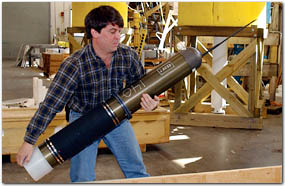
|
 |
Research > Centers > Cooperative Institute for Climate and Ocean Research
Cooperative Institute for Climate and Ocean Research
 |
 |
|
Brian Guest of the Physical Oceanography Department packs an Argo float for shipment to the Antarctic and deployment in the Drake Passage. The Institution is one of the three US groups building floats for the international program. (Photo by Tom Kleindinst) |
The Cooperative Institute for Climate and Ocean Research (CICOR) functions as the coordinating point between Woods Hole Oceanographic Institutuion and the National Oceanic and Atmospheric Administration (NOAA). The CICOR group coordinates NOAA-funded research, builds ties between researchers at WHOI and NOAA, and develops cooperative NOAA-funded research in the northeast US. CICOR is among 11 such joint institutes.
Research highlights among the 26 funded projects in 2002: Dana Yoerger of the AOPE Department collaborated with NOAA and Canadian scientists on two summer cruises along the Explorer Ridge in the North East Pacific. The WHOI Autonomous Benthic Explorer (ABE) produced highly detailed bathymetric maps that revealed new fracture systems and found hydrothermal plumes. More than 15 active chimneys were subsequently located (see Ocean Explorer).
Breck Owens and a team from the Physical Oceanography Department and program colleagues reached a milestone with the deployment of the 500th Argo float in July 2002. The floats collect profiles globally of temperature and salinity at 1,500 to 2,000 meters depth (4,950 to 6,600 feet). They surface every ten days to transmit data. They are being deployed in an international effort as part of the Global Ocean Observing System. Of the 721 active floats deployed to date, 282 are from the US (see Argo).
In October CICOR Director Bob Weller recovered and redeployed a surface mooring off the northern coast of Chile that measures surface meteorology and upper ocean temperature, salinity, and currents. These data document the coupling of the upper ocean and atmosphere under the persistent stratus clouds found west of Peru and Chile in an area believed to influence seasonal and inter-annual climate variability in the Americas. The mooring provides the first accurate and complete measurements from this region (see The Stratus Experiment).
—Robert Weller, CICOR Director
|
|
